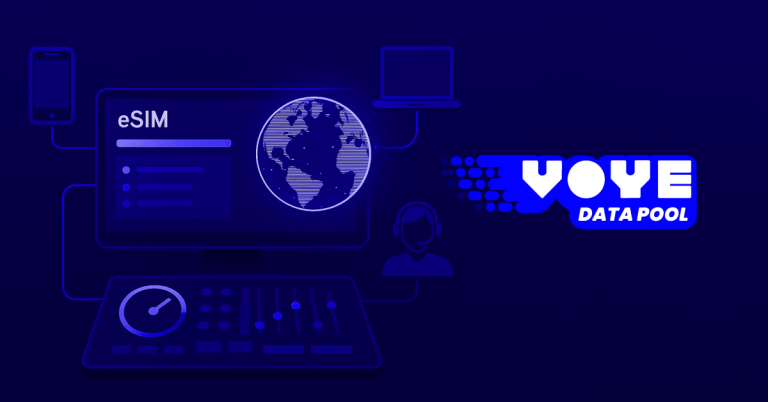B2B Connectivity in 2025: Why Flexible Data Models Matter
In 2025, B2B connectivity is evolving beyond traditional frameworks. Discover why flexible data models are becoming essential for enterprises to ensure seamless global operations, scalability, and cost-efficient communication across distributed teams.

The Connectivity Shift Businesses Can’t Ignore
The business landscape in 2025 is marked by one undeniable reality: connectivity is the new backbone of productivity. The traditional office, with centralized teams and fixed IT infrastructures, has given way to distributed workforces, hybrid models, and globally connected operations. For leaders, team heads, and HR professionals, this shift is more than a technological change — it’s a fundamental rethinking of how organizations operate.
Enterprises no longer have the luxury of relying on rigid telecom contracts or siloed connectivity models. With employees working remotely, traveling for business, or managing IoT-enabled fleets, the need for flexible, scalable, and secure data models has never been more urgent.
This is where the role of enterprise-focused platforms like Voye Data Pool comes in — offering instant eSIM activation, centralized data management, and seamless global connectivity. But before diving into solutions, it’s essential to understand why flexibility in connectivity has become a defining factor for success in 2025.
The Evolution of Enterprise Connectivity
Connectivity in business has come a long way in just a decade. Until recently, many enterprises managed global operations through traditional SIM contracts, where employees were either handed local SIM cards in different regions or relied on expensive roaming packages. These setups were not only costly but also operationally cumbersome.
- Traditional SIM-based contracts : Fixed data allowances, rigid pricing, lack of adaptability.
- Roaming challenges : Hidden costs, unreliable speeds, and inconsistent coverage.
- Operational delays : HR and IT teams are spending days organizing SIM distribution for new employees or travelers.
As global operations expanded, these inefficiencies became unsustainable. The shift toward digital-first business models forced enterprises to rethink connectivity not as a utility but as a strategic enabler.
The emergence of eSIM technology accelerated this transformation. By allowing devices to connect digitally without the need for physical SIM swaps, eSIMs opened the door for real-time activation, multi-carrier flexibility, and centralized management. Enterprises that once struggled to balance connectivity with mobility began to see the potential for data pools that could be scaled, shared, and monitored globally.
Why Flexibility Defines 2025’s Data Models
For enterprises in 2025, flexibility isn’t a nice-to-have — it’s a competitive advantage. Here’s why :
1. Workforce Mobility
Employees today move across borders for work projects, conferences, and remote assignments. A rigid connectivity model that requires a new SIM card for every region slows down productivity. Flexible data models, particularly those supported by enterprise eSIM platforms, ensure employees can connect instantly, wherever they are.
2. Scalability at Speed
Hiring surges, seasonal projects, or rapid expansion into new markets all demand scalability. With flexible models, IT managers can add or remove data allocations instantly without renegotiating telecom contracts. This level of agility allows enterprises to align connectivity with business needs in real time.
3. Cost-Efficiency
Traditional contracts often result in unused data and wasted budgets. Flexible data pools allow businesses to pay for exactly what they use, ensuring ROI is maximized. CFOs and finance leaders increasingly see connectivity as a controllable cost rather than an unpredictable liability.
4. Security and Compliance
For IT heads, connectivity is not just about bandwidth — it’s about protecting corporate data. Centralized flexible data models provide visibility and control, ensuring security policies are enforced across every connected device and region.
In short, flexible models turn connectivity from a recurring headache into a strategic lever for growth.
The HR & Operations Perspective
It’s not just CIOs and IT heads who benefit from flexible connectivity models. HR professionals and operations teams are discovering that connectivity directly impacts the employee experience.
Employee Onboarding
Remote onboarding has become the norm. With eSIM-based data pools, HR can provide new hires with immediate connectivity, no matter their location. This eliminates delays, boosts first impressions, and ensures employees can be productive from day one.
Global Workforce Enablement
For multinational corporations, employees frequently travel or relocate. Instead of juggling multiple contracts and providers, HR can rely on a single global platform that provisions connectivity seamlessly across borders.
Productivity & Retention
Research consistently shows that poor connectivity affects morale and performance. Flexible data models ensure employees don’t face dropped calls, delayed video meetings, or inaccessible collaboration tools. In a competitive talent landscape, seamless connectivity becomes a retention tool.
How Flexible Data Models Work in Practice
To understand the real impact, let’s break down how these models operate :
- Data Pooling : Instead of assigning fixed data to individual SIMs, enterprises create a central pool of data shared across employees and devices.
- Dynamic Allocation : IT managers can allocate more data to high-usage teams and reduce allocations for low-usage teams in real time.
- Centralized Management : A single dashboard allows monitoring, activation, and control over all connections globally.
- Analytics & Insights : Enterprises can track usage trends, prevent overages, and predict future needs using analytics built into the platform.
This is a significant leap from the old model of “one SIM, one plan” — moving toward a fluid, adaptive system designed for modern business.
Case Study Scenarios
1. Consulting Firm with Global Projects
A consulting company sends employees worldwide for short-term client engagements. Instead of incurring heavy roaming fees, the firm uses a data pool model where consultants tap into shared data wherever they are. Costs are predictable, and employees are always online.
2. Logistics & Fleet Management
A logistics company manages thousands of IoT-enabled vehicles and sensors. Data needs fluctuate based on routes and cargo. Flexible data pools ensure that vehicles in high-data regions get what they need, while others don’t waste resources.
3. HR in Multinationals
When onboarding 50 employees across Europe, Asia, and North America, HR avoids couriering SIM cards or negotiating local contracts. With an eSIM platform, employees are connected instantly, and IT has real-time visibility.
The Financial & Strategic Advantage
For senior executives and finance leaders, flexible data models unlock measurable advantages:
- Predictable Billing : CFOs can budget connectivity as a stable line item, free from roaming shocks.
- Maximized ROI : Every gigabyte is used efficiently, minimizing waste.
- Sustainability : No physical SIM cards means reduced plastic waste, aligning with ESG commitments.
- Competitive Edge : Businesses that stay connected everywhere can respond faster to opportunities.
Connectivity moves from being a passive expense to an active enabler of efficiency and growth.
Preparing for the Future of B2B Connectivity
Looking ahead, the connectivity demands on enterprises will only grow :
- IoT Expansion : Billions of new devices will connect to enterprise networks.
- AI & Automation : Data-heavy applications require low-latency, high-reliability connectivity.
- Hybrid Work Evolution : Employees will continue working from a mix of locations, requiring seamless connectivity.
The winners in 2025 and beyond will be the companies that embrace flexibility, scalability, and security at the heart of their connectivity models.
Where Voye Data Pool Fits In
At Voye Data Pool, we’re committed to helping enterprises unlock the power of simplified, global eSIM connectivity.
About Voye Data Pool
Voye Data Pool offers Enterprise eSIM Connectivity, Simplified. Instantly activate, manage, and monitor eSIMs across your global workforce and IoT fleet — all from one secure platform.
Why Choose Voye Data Pool
- Reliable : Built on multi-carrier global coverage.
- Scalable : Manage 10 devices or 10,000 with equal ease.
- Secure : Centralized controls with enterprise-grade encryption.
- Efficient : Minimize costs with shared data pools and real-time monitoring.
Benefits for Enterprises
- Instant Activation : No shipping delays or physical distribution.
- Centralized Management : A single dashboard for IT, HR, and operations.
- Employee-Centric : Seamless onboarding and productivity from day one.
- Cost Transparency : Eliminate unpredictable roaming bills.
Conclusion: Flexibility Is the New Competitive Edge
B2B connectivity in 2025 is no longer about choosing the cheapest plan or negotiating better roaming rates. It’s about adopting flexible data models that align with business realities — distributed workforces, global operations, and data-hungry devices.
For enterprise leaders, IT heads, and HR managers, the message is clear: connectivity is a strategic enabler, not a background utility. Companies that embrace scalable, secure, and employee-first data models will not just stay connected — they will lead in productivity, cost efficiency, and global competitiveness.

Seamless eSIM Connectivity for Enterprises
Activate, manage, and scale eSIMs with ease.
Frequently Asked Questions
What is a flexible data model in enterprise connectivity?
A flexible data model allows businesses to allocate and manage data dynamically across teams, regions, and devices, avoiding rigid contracts and wasted resources.
Why is connectivity a priority for HR and team heads in 2025?
Connectivity directly impacts onboarding, productivity, and retention. Employees expect to be connected instantly, regardless of location.
How do flexible data pools save enterprise costs?
They prevent unused data from going to waste by allowing shared, dynamic usage across the entire workforce or fleet.
Are flexible data models secure for enterprises?
Yes. With centralized dashboards, encryption, and compliance controls, enterprises gain more visibility and control than traditional SIM setups.
Why should enterprises consider eSIM-based connectivity?
eSIMs eliminate logistical hassles, enable instant activation, and support global coverage, making them ideal for modern, mobile-first enterprises.



 8 min read
8 min read





